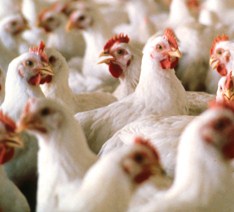USDA forecasts poultry production to take the lead

Poultry production is projected to rise the most among the meats over the next decade, as poultry is the most efficient feed-to-meat converter, according to the latest USDA Agricultural Projections report up to 2020.
Growth in the sector, however, will be slower than occurred in the 1980s and 1990s. Poultry prices are expected to improve with increased demand, although poultry will face competition from increased supplies of red meats.
Feed prices
Additionally, despite declining from recent highs, feed prices are projected to remain relatively high. Poultry production growth is expected to come from both higher bird numbers and higher average weights. Both broiler production and turkey production expand over the projection period, with broilers increasing at a slightly faster rate.
Due partly to higher feed conversion rates and a shorter production process, the poultry sector adjusts faster than the red meats sector to higher feed costs. As a result, poultry production is projected to grow throughout the decade.
Increased poultry consumption
Per capita consumption rises through the end of the projection period and, in contrast to red meats, surpasses levels of the past decade. Further, poultry meat consumption exceeds red meat consumption toward the end of the projection period.
US broiler exports rise from 2012 through the rest of the projection period. Major US export markets include China and Mexico, but US broiler exports also have been increasing to a number of other countries. Longer term gains in these markets reflect their economic growth and increasing consumer demand.
International poultry demand
International demand for poultry also remains strong because of its lower cost relative to beef and pork. US producers continue to face strong competition from other major exporters, particularly Brazil. For most of the projection period, exports from avian influenza-affected countries are expected to be limited to fully cooked products. As with pork, Russia is projected to support their domestic poultry industry by limiting imports.
During the coming decade, Brazil is expected to continue as the largest exporter of poultry products, as a result of low production costs and competitive export prices. Poultry meat imports by major importers are projected to increase by more than 1 million tons (20 percent) between 2011 and 2020. The projections indicate strong poultry import growth throughout much of the world except, most notably, for Russia, Europe, and Japan.
Source: USDA Agricultural Projections 2011-2020
Join 31,000+ subscribers
Subscribe to our newsletter to stay updated about all the need-to-know content in the poultry sector, three times a week. Beheer
Beheer








 WP Admin
WP Admin  Bewerk bericht
Bewerk bericht